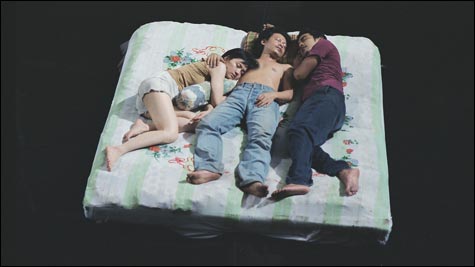
I DON’T WANT TO SLEEP ALONE: Seeking the possibility of love under discouraging conditions. |
The “New Crowned Hope” festival, with which theater director Peter Sellars helped Vienna celebrate Mozart’s 250th birthday last year, produced six features and a short that, having made the rounds of film festivals over the past year, now reach the MFA. Sellars said he wanted films from around the world that reflected the late-Mozartian themes of “magic and transformation, truth and reconciliation, and ceremonies for the dead.” It could have been a green light for the kind of prim grandiosity that has characterized Sellars’s own work. Fortunately, Simon Field and Keith Griffiths, who commissioned the series, found four directors who responded to the call with brilliant films.
The masterpiece among them, Apichatpong Weerasethakul’s SYNDROMES AND A CENTURY (September 5, 7, 8, 9, and 13), examines life in two Thai hospitals, the first in the country, the second in the city. The second part begins as a distorted recollection of the first, repeating its initial situation (a peculiar interview between two doctors). Then new lines are followed, and old connections are missed: a lovesick man no longer dares speak to his beloved, who now sits at her desk alone; a monk and a dentist fail to discover each other’s shared musical interests but are now merely present within the same frame as patient and doctor. The narrative structure helps ensure that everything is seen as if from the point of view of someone who doesn’t know the before and after of a scene but knows only the parallel of the scene.

The tremendous beauty of the film comes from its calm acceptance of the loss of contact — an acceptance that is also a subversion. All the human relationships in Syndromes are failures. A male doctor is ambivalent toward his stunning girlfriend, who wants him to move with her to a new development in the country. A young female doctor’s visit to the house of a potential suitor starts with promise but leads to ambiguity. An impromptu chakra-healing treatment fails. Even the contacts that come off in the first part of Syndromes reach a kind of tacit impasse: the monk and the dentist can’t become lovers, the woman doctor won’t love her mopy admirer. Although the film seems adrift, every scene is constructed with care around a central zone of highest intensity (a doctor’s guess at what “DDT” stands for, in the two versions of the interview) before trailing off, like a very long fade-out. A blissful meditation on the passage of things, Syndromes holds on to its images, letting it be known that even though they appear weightless, they shouldn’t be taken lightly.
The news that Taiwanese director Tsai Ming-liang was shooting a film in his native Malaysia raised expectations of a reflection on roots, but the Kuala Lumpur depicted in I DON’T WANT TO SLEEP ALONE (September 14, 15, 19, 20, and 22) is an up-to-the-minute dystopia of placelessness. Like all Tsai’s films, I Don’t Want To Sleep Alone seeks the possibility of love under discouraging conditions. The journey to Kuala Lumpur enables him to introduce a new version (with an explicit social dimension) of this theme, one involving South Asian migrant workers who squat in an unfinished car park while the city is under a cloud of smoke (said to have blown in from a massive forest fire in Indonesia). Lee Kang-sheng, Tsai’s regular star, plays two parts: a person who is severely beaten by street crooks and rescued and cared for by a migrant worker, and a coma victim being cared for by two women. No more need be said about the plot, since as always with Tsai, plot is, for much of the film, absent even as pretext.
In its more recessive and private way, I Don’t Want To Sleep Alone is as much a departure for Tsai as his previous film, The Wayward Cloud, which alienated many of his long-time supporters with its swerve into pornography. All his films have posited love as a conquest of ambivalence about the body, but I Don’t Want To Sleep Alone is the most extreme in exploring physicality as both impasse (the comatose Lee Kang-sheng) and renewal (the injured and recovering Lee Kang-sheng). It’s also the darkest of Tsai’s films — haunted by the recurrent image of the black water that fills the lower levels of the car park — and the most violent.
At the opening of Paz Encina’s atmospheric HAMACA PARAGUAYA|PARAGUAYAN HAMMOCK (September 6, 13, and 15), the camera is set up at some distance before a clearing in a forest. An elderly couple emerge through the trees in the background of the shot. They attach a hammock between two trees and sit side by side on it. They talk about the weather and about a barking dog. It becomes apparent that what most concerns them is the unknown fate of their son, who has been drafted as a soldier in their country’s border war. Through their talk, which continues on and off throughout the 78-minute film, Hamaca paraguaya becomes a moving and chilling meditation on distance, geography, and the peremptory designs of states, and Encina uses the dislocation between image and sound (and cutaways to ominous clouds) to create a shifting perceptual experience. Although its materials are limited, Hamaca paraguaya is a rich and dense film, not a sparse one.